Handsome and athletic Austrian-Polish actor Igo Sym (1896-1941) played classy gentlemen, aristocrats, and army officers in Polish, Austrian and German films of the 1920s. After the German Invasion of Poland, he co-operated with the Nazis and in 1941 he was killed by members of the Polish resistance movement.
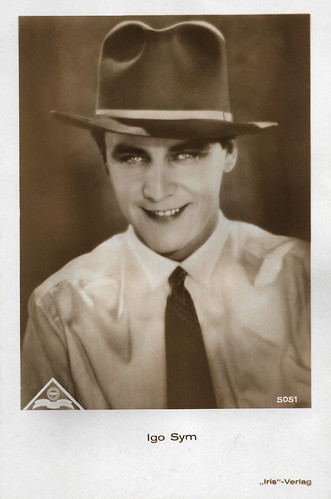
Austrian postcard by Iris Verlag, no. 5051. Photo: Sascha-Film.
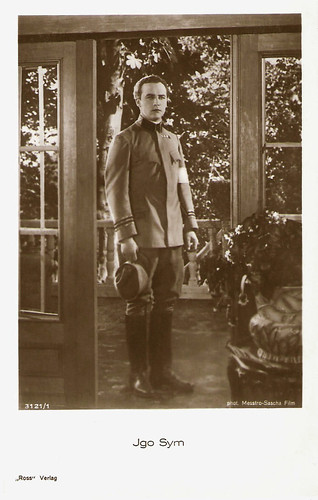
German postcard by Ross Verlag, no. 3121/1, 1928-1929. Photo: Messtro-Sascha Film.

German postcard by Ross Verlag, no. 4065/1, 1929-1930. Photo: SF (Strauss-Film). Igo Sym in Spelunke/Spunk (E.W. Emo, 1929).
Karol Juliusz ‘Igo’ Sym was born in Innsbruck, Austria in 1896.
During World War I, he served in the Austrian Army, becoming a lieutenant. After the war, he served in the Polish infantry until 1921, then took up the job of a civil servant.
His film debut took place in 1925, in the horror film Wampiry Warszawa/The Vampires of Warsaw (Wiktor Bieganski, 1925) of which no copy has been saved.
He also appeared in films like O czym sie nie mysli/That Which is Unthinkable (Edward Puchalski, 1926), and Kochanka Szamoty/Szamota's Mistress (Leon Trystan, 1927) starring diva Helena Makowska.
A handsome and athletic man, Sym usually played classy gentlemen, aristocrats, and army officers, dressed in tailcoat and uniform. In 1927 he left for Vienna, where he signed an exclusive contract with Sascha–Filmstudios AG.
To his well known silent Austrian films belong Pratermizzi (Karl Leiter, Gustav Ucicky, 1927) featuring Anny Ondra, Café Elektric/Cafe Electric (Gustav Ucicky, 1927) with Marlene Dietrich, and Erzherzog Johann (Max Neufeld, 1929) with Xenia Desni.
He then moved to Berlin where he featured in such films as Spelunke/Dives (E.W. Emo, 1929), Adieu Mascotte (Wilhelm Thiele, 1929) and Wenn du einmal dein Herz verschenkst/When You Give Your Heart Once (Johannes Guter, 1929), both opposite Lilian Harvey.
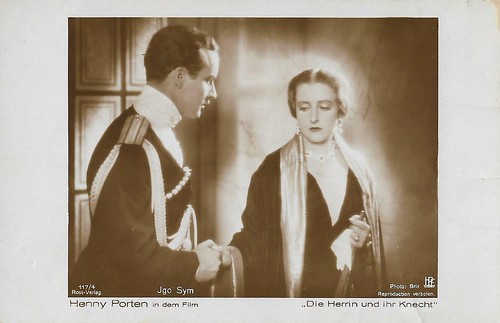
German postcard by Ross Verlag, no. 117/4. Photo Brix. Henny Porten-Froehlich-Produktion. Henny Porten and Igo Sym in Die Herrin und ihr Knecht (Richard Oswald, 1929), a drama taking place at the German-Russian border shortly before and during the First World War.
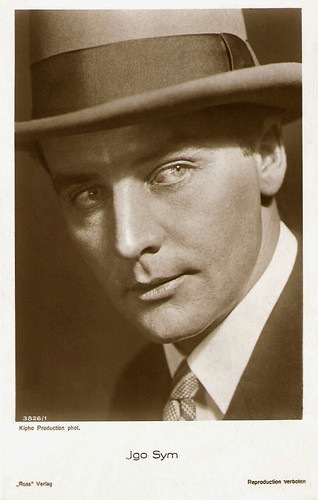
German postcard by Ross Verlag, no. 3826/1, 1928-1929. Photo: Kipho Production.
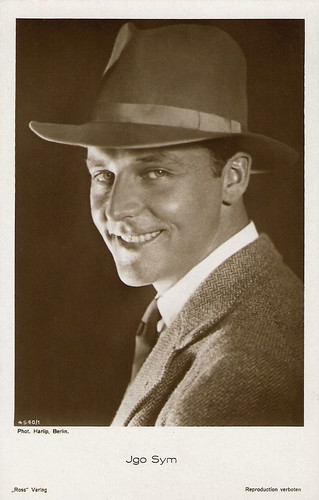
German postcard by Ross Verlag, no. 4540/1, 1929-1930. Photo: Harlip, Berlin.
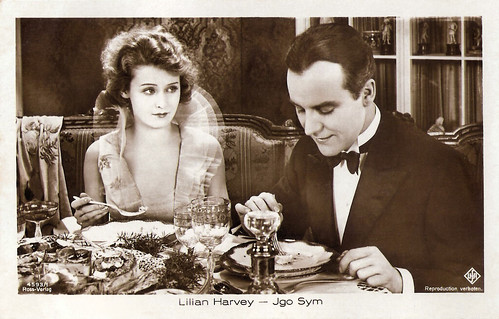
German postcard by Ross Verlag, no. 4593/1, 1929-1930. Photo: Ufa. Lilian Harvey and Igo Sym in Adieu Mascotte (Wilhelm Thiele, 1929).
At the beginning of the 1930s, Igo Sym starred in films like Gigolo/Handsome Gigolo, Poor Gigolo (Emmerich Hanus, 1930) opposite Anita Dorris, Das alte Lied/The Old Song (Erich Waschneck, 1930) with Lien Deyers, Kasernenzauber (Carl Boese, 1931) with Truus van Aalten and Ein Auto und kein Geld/An Auto and No Money (Jacob Fleck, Luise Fleck, 1932).
In 1932 he returned to Poland and settled in Warsaw. He appeared in the romance Palac na kólkach/Palace on wheels (Ryszard Ordynski, 1932), the entertaining cabaret thriller Szpieg w masce/The Spy in the Mask (Mieczyslaw Krawicz, 1933) starring famous singer Hanka Ordonówna, and the drama Przebudzenie/Awakening (Aleksander Ford, 1934).
Unexpectedly, he then concentrated on stage work in Warsaw’s theatres. He would play in revues and operettas, singing, dancing, and accompanying himself by playing the singing saw.
When the 'Deutsches Reich' invaded Poland in 1939, Sym signed the 'Reichliste' and took part as 'Volksdeutscher' in re-structuring the Polish theatre life. He became in charge of the German theatres in Warsaw.
In late 1939, Sym also became a Gestapo agent. According to preserved documents, the actor had been cooperating with Berlin before 1 September 1939. At the beginning of the war, he helped to organise a trap, in which Hanna ‘Hanka’ Ordonówna was caught.
Ordonówna had been Sym’s pre-war partner on the screen and his friend from Warsaw’s theatres. She was hiding for the Nazis but arranged one day to meet Sym at her old residence. There she was arrested by the waiting Gestapo. They put her in prison in Pawiak, but she would survive the war and died in 1950.
Polish resistance quickly found out about Sym’s involvement, and a group of agents, led by Teatr Komedia actor Roman Niewiarowicz, started to trace his activities.
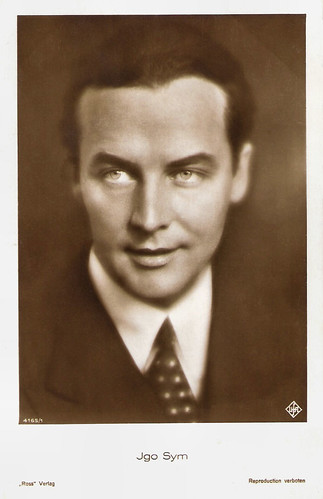
German postcard by Ross Verlag, no. 4165/1, 1929-1930. Photo: Ufa.
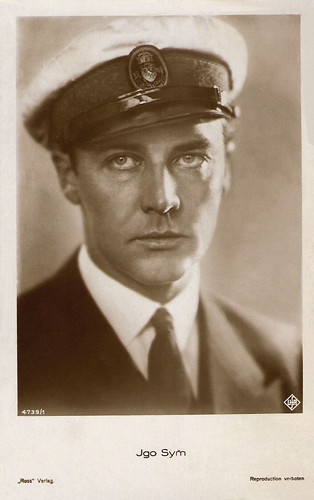
German postcard by Ross Verlag, no. 4739/1, 1929-1930. Photo: Ufa.
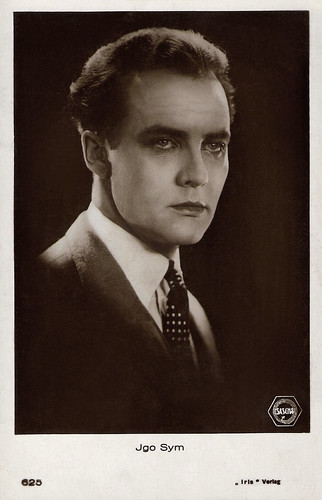
Austrian postcard by Iris Verlag, no. 625. Photo: Sascha.
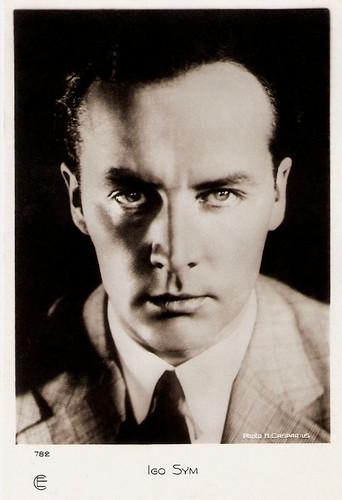
French postcard by Editions E.C. Paris, no. 782, 1929-1930. Photo: H. Casparius.
In 1940, Igo Sym successfully tried to win Polish actors to play in the German propaganda film Heimkehr/Homecoming (Gustav Ucicky, 1941). He didn’t appear in this production himself but he did play secondary roles in Zlota maska/The Golden mask (Jan Fethke, 1939) and Zona i nie zona/Wife and no wife (Emil Chaberski, 1939).
In early 1941, the headquarters of the underground Polish resistance group Związek Walki Zbrojnej (ZWZ) decided to liquidate the collaborator. Sym’s behaviour was loudly trumpeted by the Nazis, and his assassination would show the Poles that the underground movement was active, always ready to punish all traitors.
At first, the ZWZ planned to poison the actor but later decided to shoot him instead. On the morning of 7 March 1941, two Polish agents knocked at the door of Sym’s apartment in Warsaw. They told Sym that they were mailmen, carrying a dispatch. One of the agents shot Sym with a Vis pistol. Sym was struck in the heart and died on the spot. He was 44.
On the same day, German loudspeakers on the streets announced that hostages had been taken as revenge for Sym’s death. Then, posters appeared on the walls stating that more hostages would be taken and curfew would be enforced from 8 p.m. to 5 a.m. The Nazis threatened to shoot all hostages unless those responsible for the assassination were found.
All theatres were closed, and about 120 people were arrested, including teachers, physicians, lawyers, and actors. The population of Warsaw was given three days to find Sym's murderers. As nobody was found, on 11 March, 21 hostages were executed in Palmiry. Several actors were also arrested and sent to Auschwitz, among them such notable figures as directors Stefan Jaracz and Leon Schiller.
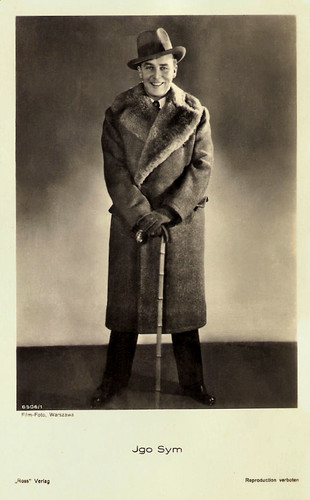
German postcard by Ross Verlag, no. 6506/1, 1931-1932. Photo: Film-Foto, Warszawa (Warsaw).
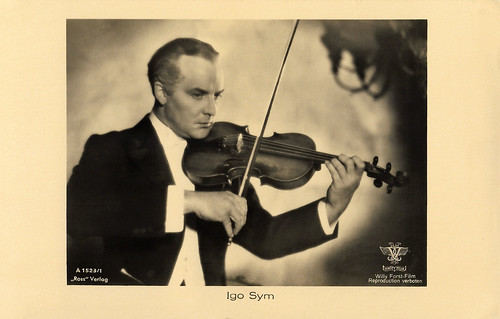
German postcard by Ross Verlag, no. A 1523/1, 1937-1938. Photo: Willi Forst-Film. Igo Sym in Serenade (Willi Forst, 1937).
Igo Sym sings 'Na całe życie' in Zona i nie zona/Wife and no wife (1939). Source: Stare Melodie (YouTube).
In 1927, Igo Sym learned Marlene Dietrich to play the Singing Saw (Singende Säge) while they worked together in Vienna. She played it in 1944 on the American radio with Paul Laval & his Band. Source: Rudi Polt (YouTube).
Sources: Thomas Staedeli (Cyranos), Wikipedia, and IMDb.

Austrian postcard by Iris Verlag, no. 5051. Photo: Sascha-Film.

German postcard by Ross Verlag, no. 3121/1, 1928-1929. Photo: Messtro-Sascha Film.

German postcard by Ross Verlag, no. 4065/1, 1929-1930. Photo: SF (Strauss-Film). Igo Sym in Spelunke/Spunk (E.W. Emo, 1929).
Tailcoat and uniform
Karol Juliusz ‘Igo’ Sym was born in Innsbruck, Austria in 1896.
During World War I, he served in the Austrian Army, becoming a lieutenant. After the war, he served in the Polish infantry until 1921, then took up the job of a civil servant.
His film debut took place in 1925, in the horror film Wampiry Warszawa/The Vampires of Warsaw (Wiktor Bieganski, 1925) of which no copy has been saved.
He also appeared in films like O czym sie nie mysli/That Which is Unthinkable (Edward Puchalski, 1926), and Kochanka Szamoty/Szamota's Mistress (Leon Trystan, 1927) starring diva Helena Makowska.
A handsome and athletic man, Sym usually played classy gentlemen, aristocrats, and army officers, dressed in tailcoat and uniform. In 1927 he left for Vienna, where he signed an exclusive contract with Sascha–Filmstudios AG.
To his well known silent Austrian films belong Pratermizzi (Karl Leiter, Gustav Ucicky, 1927) featuring Anny Ondra, Café Elektric/Cafe Electric (Gustav Ucicky, 1927) with Marlene Dietrich, and Erzherzog Johann (Max Neufeld, 1929) with Xenia Desni.
He then moved to Berlin where he featured in such films as Spelunke/Dives (E.W. Emo, 1929), Adieu Mascotte (Wilhelm Thiele, 1929) and Wenn du einmal dein Herz verschenkst/When You Give Your Heart Once (Johannes Guter, 1929), both opposite Lilian Harvey.

German postcard by Ross Verlag, no. 117/4. Photo Brix. Henny Porten-Froehlich-Produktion. Henny Porten and Igo Sym in Die Herrin und ihr Knecht (Richard Oswald, 1929), a drama taking place at the German-Russian border shortly before and during the First World War.

German postcard by Ross Verlag, no. 3826/1, 1928-1929. Photo: Kipho Production.

German postcard by Ross Verlag, no. 4540/1, 1929-1930. Photo: Harlip, Berlin.

German postcard by Ross Verlag, no. 4593/1, 1929-1930. Photo: Ufa. Lilian Harvey and Igo Sym in Adieu Mascotte (Wilhelm Thiele, 1929).
Singing Saw
At the beginning of the 1930s, Igo Sym starred in films like Gigolo/Handsome Gigolo, Poor Gigolo (Emmerich Hanus, 1930) opposite Anita Dorris, Das alte Lied/The Old Song (Erich Waschneck, 1930) with Lien Deyers, Kasernenzauber (Carl Boese, 1931) with Truus van Aalten and Ein Auto und kein Geld/An Auto and No Money (Jacob Fleck, Luise Fleck, 1932).
In 1932 he returned to Poland and settled in Warsaw. He appeared in the romance Palac na kólkach/Palace on wheels (Ryszard Ordynski, 1932), the entertaining cabaret thriller Szpieg w masce/The Spy in the Mask (Mieczyslaw Krawicz, 1933) starring famous singer Hanka Ordonówna, and the drama Przebudzenie/Awakening (Aleksander Ford, 1934).
Unexpectedly, he then concentrated on stage work in Warsaw’s theatres. He would play in revues and operettas, singing, dancing, and accompanying himself by playing the singing saw.
When the 'Deutsches Reich' invaded Poland in 1939, Sym signed the 'Reichliste' and took part as 'Volksdeutscher' in re-structuring the Polish theatre life. He became in charge of the German theatres in Warsaw.
In late 1939, Sym also became a Gestapo agent. According to preserved documents, the actor had been cooperating with Berlin before 1 September 1939. At the beginning of the war, he helped to organise a trap, in which Hanna ‘Hanka’ Ordonówna was caught.
Ordonówna had been Sym’s pre-war partner on the screen and his friend from Warsaw’s theatres. She was hiding for the Nazis but arranged one day to meet Sym at her old residence. There she was arrested by the waiting Gestapo. They put her in prison in Pawiak, but she would survive the war and died in 1950.
Polish resistance quickly found out about Sym’s involvement, and a group of agents, led by Teatr Komedia actor Roman Niewiarowicz, started to trace his activities.

German postcard by Ross Verlag, no. 4165/1, 1929-1930. Photo: Ufa.

German postcard by Ross Verlag, no. 4739/1, 1929-1930. Photo: Ufa.

Austrian postcard by Iris Verlag, no. 625. Photo: Sascha.

French postcard by Editions E.C. Paris, no. 782, 1929-1930. Photo: H. Casparius.
Collaborator
In 1940, Igo Sym successfully tried to win Polish actors to play in the German propaganda film Heimkehr/Homecoming (Gustav Ucicky, 1941). He didn’t appear in this production himself but he did play secondary roles in Zlota maska/The Golden mask (Jan Fethke, 1939) and Zona i nie zona/Wife and no wife (Emil Chaberski, 1939).
In early 1941, the headquarters of the underground Polish resistance group Związek Walki Zbrojnej (ZWZ) decided to liquidate the collaborator. Sym’s behaviour was loudly trumpeted by the Nazis, and his assassination would show the Poles that the underground movement was active, always ready to punish all traitors.
At first, the ZWZ planned to poison the actor but later decided to shoot him instead. On the morning of 7 March 1941, two Polish agents knocked at the door of Sym’s apartment in Warsaw. They told Sym that they were mailmen, carrying a dispatch. One of the agents shot Sym with a Vis pistol. Sym was struck in the heart and died on the spot. He was 44.
On the same day, German loudspeakers on the streets announced that hostages had been taken as revenge for Sym’s death. Then, posters appeared on the walls stating that more hostages would be taken and curfew would be enforced from 8 p.m. to 5 a.m. The Nazis threatened to shoot all hostages unless those responsible for the assassination were found.
All theatres were closed, and about 120 people were arrested, including teachers, physicians, lawyers, and actors. The population of Warsaw was given three days to find Sym's murderers. As nobody was found, on 11 March, 21 hostages were executed in Palmiry. Several actors were also arrested and sent to Auschwitz, among them such notable figures as directors Stefan Jaracz and Leon Schiller.

German postcard by Ross Verlag, no. 6506/1, 1931-1932. Photo: Film-Foto, Warszawa (Warsaw).

German postcard by Ross Verlag, no. A 1523/1, 1937-1938. Photo: Willi Forst-Film. Igo Sym in Serenade (Willi Forst, 1937).
Igo Sym sings 'Na całe życie' in Zona i nie zona/Wife and no wife (1939). Source: Stare Melodie (YouTube).
In 1927, Igo Sym learned Marlene Dietrich to play the Singing Saw (Singende Säge) while they worked together in Vienna. She played it in 1944 on the American radio with Paul Laval & his Band. Source: Rudi Polt (YouTube).
Sources: Thomas Staedeli (Cyranos), Wikipedia, and IMDb.
No comments:
Post a Comment